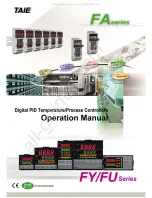
Page 6
4 Features TCR511PCI
4 Features TCR511PCI
The board TCR511PCI was developed for computer systems with PCI-bus. It is designed as an universal board
and can be used in systems with either 3.3 V or 5 V PCI slots therefore. The module supports clock speeds of 33
MHz and 66 MHz. TCR511PCI serves to receive and decode modulated (AM) and unmodulated (DC Level Shift)
IRIG and AFNOR time codes. AM-codes are transmitted by modulating the amplitude of a sine wave carrier,
unmodulated codes by variation of the width of pulses.
Automatic gain control within the receive circuit for modulated codes allows decoding of IRIG signals with a
carrier amplitude of 600 mVpp to 8 Vpp. The input stage is elecctically insulated and has an impedance of 50
Ω
,
it is accessible via the BNC connector in the bracket of TCR511PCI.
Unmodulated time codes must be connected to the D-Sub-plug of the module. An onboard photocoupler insulates
the internal receive circuit. In delivery state of TCR511PCI the contacts of the D-Sub-plug are not connected to
the photocoupler. Two DIP-switches must be set to the `ON' position for making this connection.
The board TCR511PCI provides a congurable serial interface (RS-232), a pulse per second (PPS) with TTL
or RS-232 level and a pulse per minute (PPM) with TTL level. Like the photocoupler, these signals are only
connected to the D-Sub-plug after setting DIP-switches into the `ON' position.
Software running on the computer can read out information regarding date, time and status of the IRIG re-
ceiver. Access to the board is made via writing to/reading from I/O ports. It is possible but not necessary to let
the board generate periodic hardware interrupts on the computer bus. Driver software supplied with the board
is keeping the computer's system time synchronous to the board time. If the USB Flash Memory, delivered with
TCR511PCI, doesn't include a driver for the used operating system, it can be downloaded free of charge at:
http://www.meinberg.de/english/sw/
Manuals for the drivers are available at this site also. The microprocessor system of TCR511PCI is equiped
with a Bootstrap-Loader and a Flash-EPROM. These features enable updating of the onboard software via the
serial RS-232 interface COM0 by using a Flash Program.
4.1 Functional description
After the received IRIG code has passed a consistency check, the software clock and the battery backed realtime
clock of TCR511PCI are synchronized to the external time reference. If an error in the IRIG telegram is detected,
the system clock of the board switches to holdover mode. Drifting of the internal time base and the generated
pulses (PPS/PPM) is limited to 1
µ
sec/sec by regulating the onboard quartz of TCR511PCI. IRIG code includes
day of year information only. The complete date is kept in the battery backed realtime clock and the software
clock therefore. The received day of year is compared to this complete date once per minute. If the board
detects a dierence between received and stored date information, TCR511PCI switches to holdover mode but
still synchronizes the internal time base to the received IRIG code.
Date and time kept in the realtime clock can be set by sending a Meinberg Standard Time Telegram to the
serial interface COM0 or via the PCI-Express bus.
6
Date: 2009-06-24
TCR511PCI





































